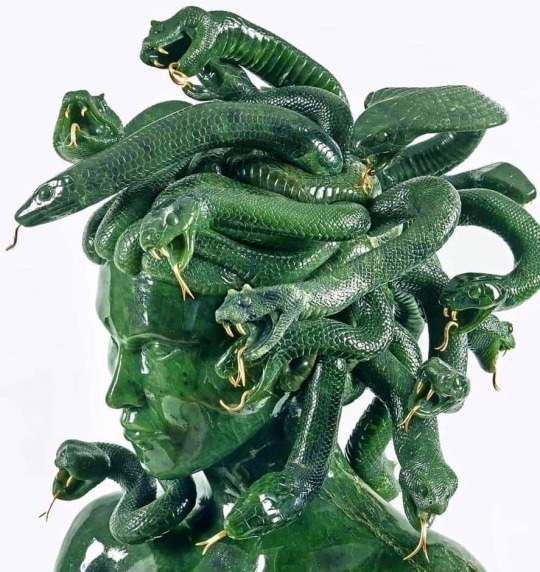Text

https://www.instagram.com/p/CSId67CAo8R/?utm_medium=copy_link
3K notes
·
View notes
Text
it’s not that I’m unwilling to talk about the way the show has grown over the past three years,
but so many of those comments start with statements that are essentially “well the first part of the show was objectively dogshit and literally everyone hated those seasons, but I’m glad the showrunner finally came to understand my opinions are the correct ones and he took on that feedback and now is starting to make a decent show”
and like, I fucking liked the first two seasons and truth be told I have excellent taste so the above is just sort of a nonstarter for me
#I've introduced two friends who never read the books to the show#And they both loved it from the very first episode so :/ the first seasons are NOT bad#As much as people want to pretend they are.
278 notes
·
View notes
Text
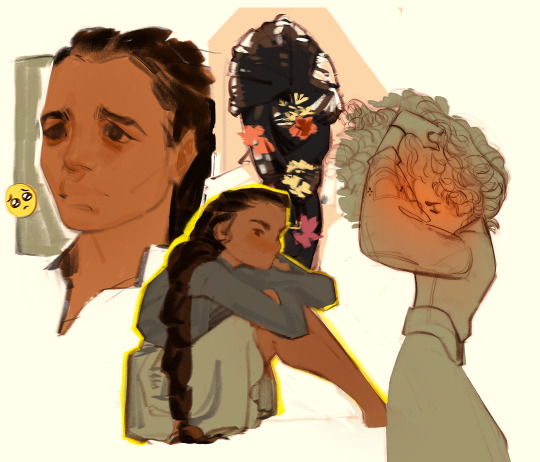
got a little teary eyed after thinking about nynaeve al’meara too much
298 notes
·
View notes
Text





The Wheel of Time, 2025 Season 03, Episode 04: The Road to the Spear
619 notes
·
View notes
Text
Watching polycules form in real time is like watching an earthquake and a tsunami strike at the same location
26K notes
·
View notes
Text
they do not go in the direction you think they will go
20K notes
·
View notes
Photo


Errol Le Cain - illustration of ‘Thorn Rose’, a version of Sleeping Beauty.
12K notes
·
View notes
Text
rocky horror was ahead of its time Not because of the blatant queerness but because frank n furter's castle was wheelchair accessible
33K notes
·
View notes
Text


Historically Accurate Jasmine
Another remake! I remade Jasmine for my series of "Historically Accurate" Disney Princesses. I honestly don't like the first version of Jasmine I made five years ago. It's not well drawn, I don't like the design, it doesn't look Jasmine and I incoherently mixed elements from different time periods. I also made some embarrassing blunders in history while explaining my thought process, since back then I was much less familiar with the history of Middle East and India. So I definitely wanted to redo her.
I do like Aladdin a lot, but let's be real, it's a very Orientalist film. Orientalism is the colonial lens through which the west looks at Asia and North-Africa, or the so called "Orient". It's dehumanizing and fetishistic lens - the west at the same time despises and covets the "Oriental" body. The "Orient" is flattened as one single entity and it's all savage and exotic, backward and mystical. Orientalism is fueled by jealousy and entitled superiority. In Aladdin it's very visible in how the setting blends a lot of very different Asian cultures, flattening large parts of a very diverse continent. It's set in sandy desert, but a lot of the elements of dress especially are much more Indian in aesthetic. Certainly fitted bodices and exposed stomachs are not practical clothes in a desert climate. The characters too are frequently exotised and fetishised with most female characters including Jasmine dressed and posed to appeal to the colonial gaze that covets brown bodies. Jasmine is sexualised much more that any of the white Disney princesses.
Originally the story was going to be more focused, though I can't imagine it ever lacking in Orientalism. It was supposed to be set in Baghdad, but during the production the First Gulf War happened, so they tried to distance it from the original Iraqi setting by setting it to the fictional city of Agrabah. Would there have been less Indian elements? Probably. It is pointed that in the wake of American forever wars in the Middle East, to not cause a stir Disney elected to make the movie more Orientalist. Orientalism was the inoffensive option.
Deciding on the historical setting to ground the redesign in was not simple considering the mess that the movie's setting is. One Thousand And One Nights is a collection (or many collections) of Islamic folktales from Northern Africa to Central and South Asia. So India (especially Mughal India ruled by Muslim dynasty) wouldn't be an incorrect setting and certainly neither would Middle East. The problem is that the film seems to imply there's no meaningful difference. Rather than trying figure out what is the most fitting place and time period for the film, I looked to the origins of the story of Aladdin. Apparently Aladdin’s story was added to One Thousand And One Hundred Nights by a French translator in 1709. He got the story from a Syrian-born Maronite storyteller, Hanna Diyab, who might have come up with the story himself. Most of Syria (at least Aleppo where he was born) was at the time part of Safavid dynasty Persia, so I decided to set my version of Jasmine in 17th century Persia.
I basically based the design on the illustration from 1702-3 by Mu'in Musavvir first below. The more fitted and tailored style with wider skirt likely influenced by European fashion it represents became fashionable in mid 17th century, so it still fits the time period I'm aiming at. The colour is simply perfect for Jasmine and I really like the overall desing. I did look at other art as well to get a better understanding on how the cut of the dress works, so here's couple o more references: second one is "Two Lovers with a Servant Woman" from 1696 by Mu'in Musavvir as well, third and fourth are details from paintings in the Chehel Stoun palace in Isfahan from 1646. Eyebrows grown together was considered especially beautiful feature so of course I gave Jasmine brows like that.
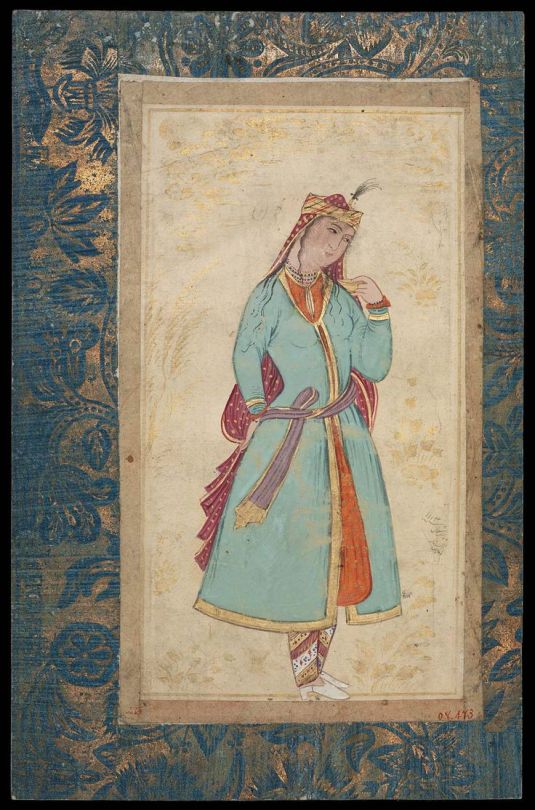
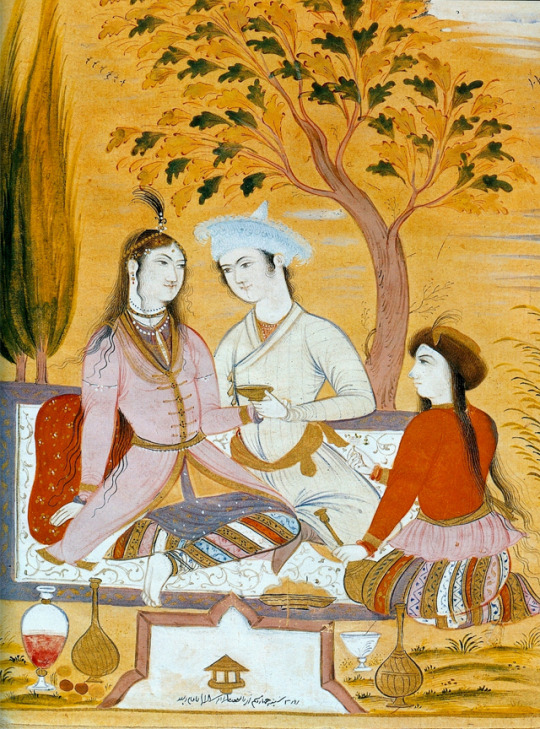

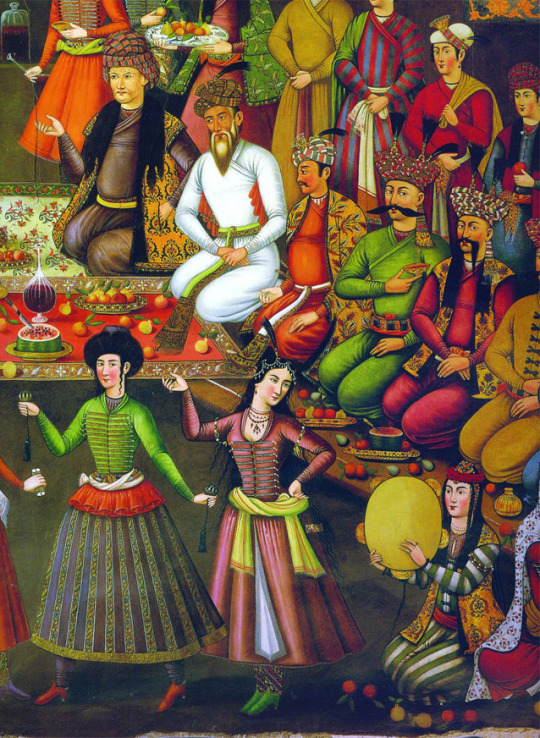
I of course gave her a crown, since she's a princess and depictions of Safavid princesses seem to always have a crown. I found that usually in art women had a white veil with their crown which is why I made her veil white, even though with the scarf band, which was the more typical headwear for women, colourful veils seemed to have been much more popular at the time. The veils in 17th century were also very long. For the crown and jewelry I wasn't as concerned to be using references from mid to late 17th century specifically, since these tend to change slower than other fashions. I based the crown mostly on the first illustration below from c. 1600 by Muhammad-Sharif Musawwir of a Seated Princess and the earrings on the second illustration from c. 1540 by Mirza ‘Ali of a Seated Princess with a Spray of Flowers.
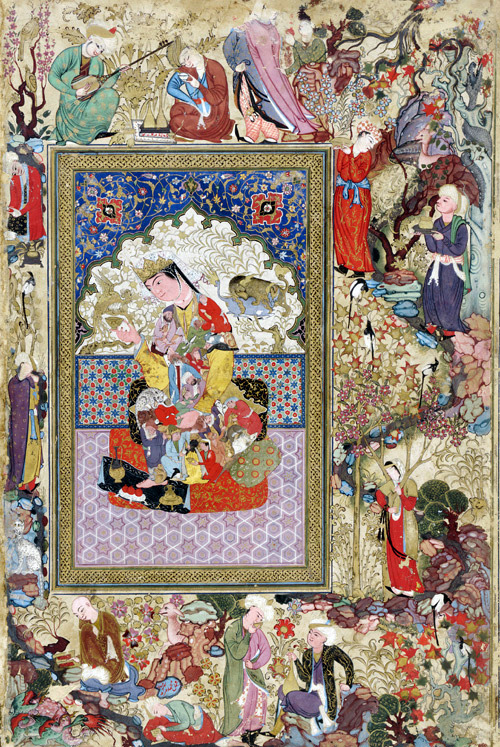

Most of the images I found on this very useful blog which had gathered A LOT of Persian illustrations and paintings in handy timeline. A lot of the information of Safavid fashion I got from this MET Museum write up by Nazanin Hedayat Munroe.
661 notes
·
View notes
